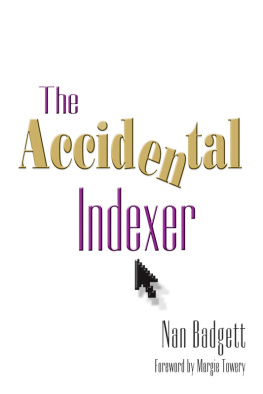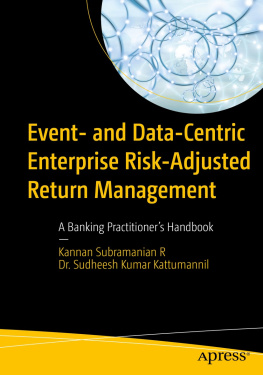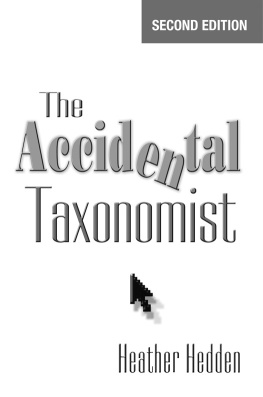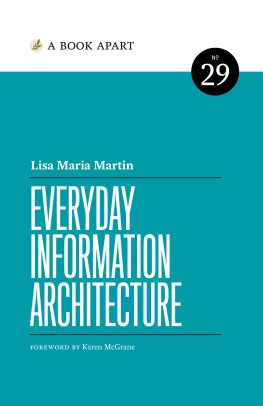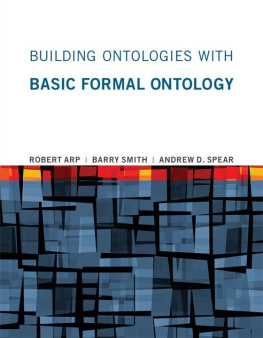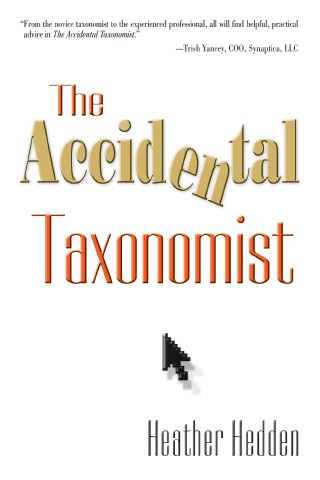
Second Printing, October 2010
The Accidental Taxonomist
Copyright 2010 by Heather Hedden
All rights reserved. No part of this book may be reproduced in any form or by any electronic or mechanical means, including information storage and retrieval systems, without permission in writing from the publisher, except by a reviewer, who may quote brief passages in a review. Published by Information Today, Inc., 143 Old Marlton Pike, Medford, New Jersey 08055.
Publishers Note: The author and publisher have taken care in preparation of this book but make no expressed or implied warranty of any kind and assume no responsibility for errors or omissions. No liability is assumed for incidental or consequential damages in connection with or arising out of the use of the information or programs contained herein.
Many of the designations used by manufacturers and sellers to distinguish their products are claimed as trademarks. Where those designations appear in this book and Information Today, Inc., was aware of a trademark claim, the designations have been printed with initial capital letters.
Library of Congress Cataloging-in-Publication Data
Hedden, Heather.
The accidental taxonomist / Heather Hedden.
p. cm.
Includes bibliographical references and index.
ISBN 978-1-57387-397-0
1. Information organization. 2. Classification. 3. Indexing. 4. Subject headings. 5. Cross references (Information retrieval). 6. Thesauri. I. Title.
Z666.5.H43 2010
025--dc22
2010008320
Printed and bound in the United States of America
President and CEO: Thomas H. Hogan, Sr.
Editor-in-Chief and Publisher: John B. Bryans
Managing Editor: Amy M. Reeve
VP Graphics and Production: M. Heide Dengler
Book Designer: Kara Mia Jalkowski
Cover Designer: Ashlee Caruolo
www.infotoday.com
In one sense, taxonomy work, as the practice of naming and organizing things, is an ancient art. In another sense, it is a thoroughly modern one, taking on new and more challenging characteristics as organizations and human societies have become more information intensive.
With the arrival of affordable computing in the 1980s, simple economics pushed information into digital formats. The economic opportunities for distributing information on much larger scales also required the development of new tools and more specialized skills for organizing and retrieving digital content collections. This activity was still fairly localized within the holders of large content collections: libraries, publishers, and content aggregators such as online databases.
We can trace the first generation of modern taxonomists to this new activity in the digital domain in the 1980s.
The blossoming of the internet in the 1990s began a much more universal information availability cascade, and this made problems of information navigation and retrieval both more widespread and more acute.
This problem has largely been addressed on the internet through increasingly sophisticated search. Search can satisfy this need on the internet because it can exploit two unique features of the internet:
Super availability of information means that useful content can be found for almost any purpose.
Social clues about useful content such as links and references can lift content that has been recognized as useful to the top of search results.
So the internet in itself had little direct impact on the nature or importance of taxonomy work and taxonomy professionals, except to illustrate that there are other mechanisms than the use of taxonomies and taxonomists to support navigation and retrieval.
The internet has had an indirect impact and a much more far reaching one for taxonomists than that first affair with digital information in the 1980s. The public world of the internet and the technology it represents has put incredible pressure on enterprises and governments to become faster, better, and cheaper at what they doand the ability to manipulate data and information has become a key competitive driver.
Organizational information, whether exposed to the world through ecommerce websites or databases, or whether transferred and accessed within firewalls, cannot easily leverage the two features of the internet, super-abundance of information and social clues:
They have abundance (which drives the need to organize and navigate) but not super-abundance.
They are typically organized into functional or market silos, and so social clues about value are not readily available, because there is little linking activity across silos to leverage.
Taxonomists and taxonomies have therefore become major instruments for analyzing content, purposes, and needs, and designing taxonomies to help people find content whatever their need. Technology-driven tools have not yet demonstrated that they can reliably substitute for the skills of taxonomists for helping information systems meet the diverse and specialized purposes and needs of knowledge workers within enterprises.
The past decade has therefore seen a much larger demand for taxonomy work and a greater variety of types of taxonomy work. An ancient art has become a thoroughly modern practice, with quite new and quite challenging characteristics. One of those is that taxonomy work is now very diverse. It no longer has the clearly defined boundaries it used to have.
Taxonomy professionals need to know about the technology environments they are designing for; they need to be able to analyze the business needs of their clients; they need to understand the information and knowledge requirements of their users, the characteristics of the content they are covering; they need consulting, project management, and communication skills; they need to know about the use of standards and the current developments and trends in both technology and standards, because they are constantly changing. This is all over and above the traditional theory and specialized skills that go into the creation and application of effective taxonomies.
There are no taxonomy schools out there to supply this need, as Heather Hedden points out in this book. The need for information organization has drawn practitioners from several loosely related disciplines: librarianship, publishing, information architecture, indexing, data, and information and knowledge management, among others. So we have a loose coalition of taxonomy professionals of varying levels of experience, many of them teleported into taxonomy work from elsewhere (or accidental taxonomists, as Hedden puts it), many of them combining taxonomy responsibilities with other duties, and bringing different backgrounds, skills, and approaches to their work.
The field desperately needs a practical literature to bring together the key elements of taxonomy work for this diverse range of practitioners, particularly for those who have found themselves with taxonomy responsibilities without much prior theoretical or technical preparation.
This is slowly starting to change. When I published my book Organising Knowledge (2007), there was no other comparable book in the field of taxonomy work. Bowker and Stars Sorting Things Out (1999) provided a brilliant theoretical underpinning for modern taxonomy work, but there was little guidance on how to bring this theory to meet the problems of organizational information and knowledge management. If we use an aerial metaphor, Bowker and Star provided a perspective at 30,000 feet.
My goal in Organising Knowledge was to give a perspective closer to the ground, but because it focuses on the value of taxonomy work as a strategic intervention, it still works at a fairly high levellets say 1,000 feet. Darin Stewarts book,



